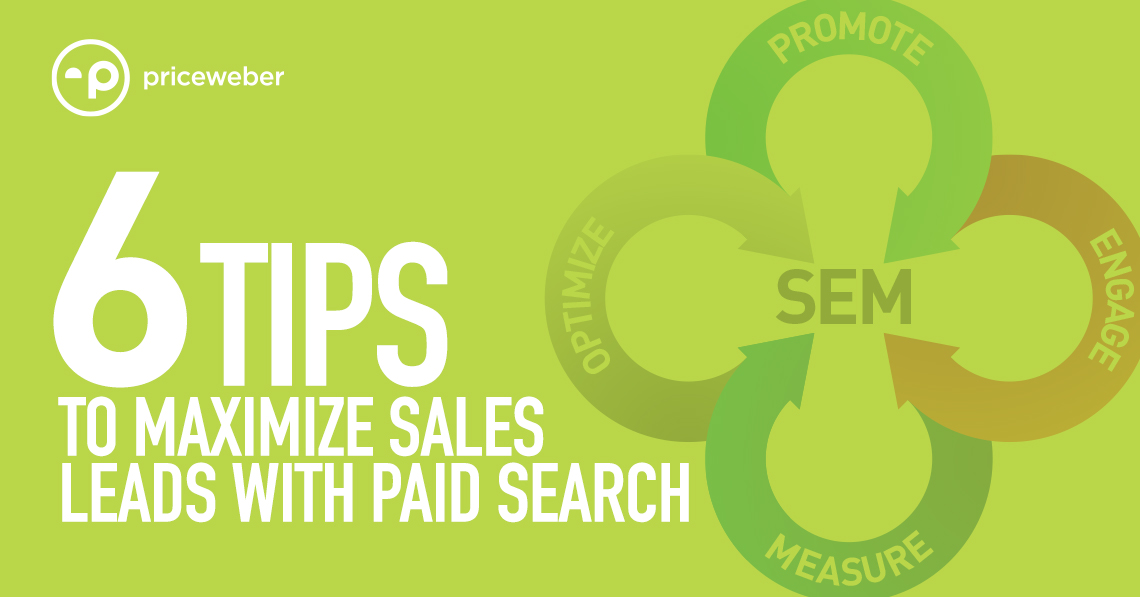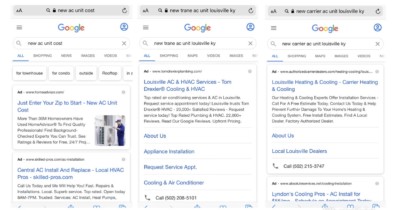Whether your focus is on B2B marketing or B2C, there are few topics more relevant today than generating qualified leads to move your sales forward. There are a great number of ways to do this (in combination for best results), but in today’s edition of Plain Talk, we’ll be discussing the anchor tactic for “pay-per-click” advertising: paid search marketing.
Why Paid Search?
Paid search has become a critical platform for most brands. It is one of the lower-cost/higher-conversion tactics and can complement any plan. Paid search allows us to reach people who are actively searching for products or information (hand-raisers) and allows brands to immediately provide them with a potential solution. From a consumer experience perspective, nearly 65% of people click on Google Ads when they are looking to buy and most people still don’t actively recognize the difference between a paid ad and an organic search listing.
Google has been the platform of choice for many marketers, and today, roughly 73% of paid search budget is spent with them. They get the bulk for good reason – they get 70-80% market share of searches on desktop and 94% on mobile devices. Other search engines like Yahoo, MSN or Bing certainly have their place depending on the client and their goals, but with the majority of market share, Google is almost always the best place to start.
Another reason to include paid search in your plan is that for many brands, it represents the opportunity to snatch a motivated buyer at a moment of truth. While traditional media does a great job of scaling awareness and intent, searching customers are actively looking for your product (or your competitors). Because of this, active “hand-raising” searches can quickly generate more qualified leads and provide measurable sales results while improving brand recognition and awareness. It can also be extremely budget friendly.
However, given that your brand can snatch a competitor’s hand-raiser, likewise, your competitor can try to grab yours, so paid search can also be an effective competitive “blunting” tool to protect your business from losing high-value online traffic.
As with anything, if you are going to do paid search, you need to do it right. Search can have a high ROI when done well, and it’s easily measurable. Here are the top six best practices to do paid search well.
1. Keywords Are the Foundation of a Good Search Strategy
Paid search relies on using the right keywords to reach the right customer when they are searching for products, services or solutions that your company offers. Keyword research is essential to find words that your target audience uses. To be successful, you need to think creatively, but also think about the intent of the searcher. Keys to keyword success:
- Don’t go too broad – this will get you a lot of traffic, but you’ll also spend a lot of money on people who are not looking for your solution. For example, someone looking for “women’s fashion” isn’t looking for anything very specific, but someone searching for “affordable women’s fall dress styles” is more likely to get a narrower and more specific search result.
- Use and test various match types: broad match, broad match modified, phrase match and exact match. These tell Google what types of searches are most relevant. Broad match may seem like the easiest way to go since it would catch any search remotely related to your keyword, but there is a lot of waste.
- Use negative keywords to weed out irrelevant traffic. If you are selling personal loans, you may want to eliminate traffic around personal injury loans.
- Use a mix of short, one-word keywords and longer-tail (3+ word) terms. Long-tail keywords generally have lower competition and search traffic, but those keywords tend to have a much higher conversion rate when chosen strategically.
- Limit investment on branded key search terms. If someone is searching for your company by name, they are likely already familiar with you and are more likely to be a current customer or someone who is ready to “convert.” Branded terms do have a place in your search campaigns but should represent a small portion of your budget.
- Consider the full funnel – awareness, consideration and decision.
- Awareness searches may include additional words around improve, prevent, issue or information.
- Consideration searches may include your keyword plus solution, service, tool or provider.
- Decision searches may include things like compare, review, pros or cons.
2. Consider Your Business Goal and Ensure Tracking Is Set Up
One of the main benefits of paid search is the ability to measure results and tie them directly to your business goals. Depending on your overall goals, there may be certain things that are more important to measure. Ensure that your Google Analytics account is linked to your paid search campaigns and set up all relevant conversion goals so that you can see what types of conversion actions people are taking with their ads.
This could be phone calls, form completions, lead generation (email, name, etc.), or, as a local retail location, the address or locator function may be more important. If awareness is the goal, then even page views and time spent on the page may be important to monitor. By having these things linked, you can optimize your paid search toward that key performance indicator.
3. Ad Copy Is About Relevance + Real Estate
Paid search competes on a bid system. We set the amount we are willing pay for a specific keyword on a cost-per-click basis. If we win the bid, our ad is served. But winning the bid is not just about the amount we are willing to spend; it comes down to our ad rank.
Google determines ad rank based on the max bid and quality score, meaning the more relevant the ad is to the keyword AND the landing page, the more likely it is to be served. Someone can bid a lower dollar amount on a search term and still win bids more often if they have good overall relevance. Google also prioritizes those who make use of extensions. Per Google, “if two competing ads have the same bid and quality, the ad with the more positive expected impact from extensions will generally appear in a higher position than the other.” This means the goal has shifted from simple relevance to relevance plus real estate. Here are some best practices to make the most of your ad copy:
- Use high-volume keywords in headlines and descriptions to improve relevancy.
- Similarly, use these words on the landing page in content for SEO.
- Connect copy to intent, include a clear call to action and communicate reader benefits, just as you would in any ad development.
- Don’t use run-on headlines.
- Each headline should stand on its own – don’t expect Headline 2 to be a continuation of Headline 1. The headlines should work separately or in a different order.
- Don’t use periods or exclamation points in the headlines.
- Use top keywords in the path field for the display URL (this does NOT have to be the actual path or URL; this is simply a display URL to show relevance.)
- Capitalize the first letter of each word in your ad – again the point is to make the ad appear bigger on the page.
- Enable all the extensions possible (ensuring it makes sense for your business) – site links, callout extensions, structured snippets, locations, etc.
- Note: You can use dynamic keyword insertion in the headlines, but make sure that it makes sense and will fit within the character limits.
Even if you develop the best ad copy, it still needs to be tested and optimized regularly. Additionally, there are different types of ads that should be utilized. There are standard text ads with three headlines and two descriptions. There are also responsive search ads where you can load 10 headlines and up to four descriptions and allow Google to optimize based on the best combination available. Dynamic ads allow you to load two descriptions, but Google chooses the headlines based on the search and the available landing pages. These can work extremely well, but it’s important to use a variety of ad times.
4. Landing Pages Close the Sale
Quality score and ad relevance don’t just depend on the keywords and the ad copy. The landing page your ad leads to should be closely relevant to both. The goal of paid search is to get someone interested enough to go to your page and take a desired action. But it’s up to the landing page to close the deal.
It’s important to continue to refine your landing pages, updating content, adding calls to action and analyzing performance on site, just as you would analyze results within your paid search campaign.
5. Ongoing Optimizations Are Key
Paid search is not something you can set and forget. It requires ongoing, often daily, optimizations and monitoring. Some key things you need to be looking at regularly include:
- Keyword Optimization – continue testing different match types. Don’t be afraid to pause or eliminate keywords that aren’t working. It’s okay if you aren’t always in the #1 position for a specific keyword, but you want to balance being at the top of the page while also remaining cost efficient against your goals.
- Analyze the Search Queries – this will show you what people are actually searching and how your keyword is matching to that search string. If something is extremely relevant, you may want to add a long-tail keyword. Or if that search query is not relevant, it may indicate that you need to add some additional negative keywords.
- Keep the campaign manageable – the account structure is important, and logical keyword grouping can help achieve a higher CTR, lower CPC and stronger performance. Bigger is not always better – a smaller group of focused ad groups and keywords can be extremely successful and is definitely easier to manage.
- Understand devices your customer is using – some audiences and campaigns are more likely to use desktop, and some convert more often on mobile. Make sure your pages are mobile friendly. Bid adjust to the best performing devices.
- Monitor budget and impression share – if you are having problems with specific keywords, ad groups or campaigns, you may look to some additional adjustments to improve performance:
- Location bid adjustments ensure you aren’t wasting money on geographical areas that aren’t converting.
- Hour of day and day of week – consider not only when people are searching but also when they can act on that information. Make sure you are running your campaigns when it makes sense and when you can generate the most conversions (for your goals). You can bid adjust or pause certain days or times as it makes sense, to preserve your budget.
- Monitor search partner networks. Sometimes these can generate positive results at a low cost, but if they don’t, you should turn them off.
- Monitor competitors’ search presence, ad copy and landing page content for information to stay relevant and competitive (or to find ways to edge ahead in a consumer’s consideration set).
6. Targeting Considerations
While paid search focuses on keyword selection, you can also target specific audiences. Google has a lot of ways to do this, but whether it makes sense will vary by brand and campaign:
- Remarketing Lists for Search Ads (RSLA) – this can be helpful in continuing to target people who have already visited your site. You can serve them a unique ad to increase the likelihood they will convert. Or you can eliminate people who have already visited your site so that you don’t continue talking to them.
- Customer-matched lists – you can upload CRM data to target that group with specific messaging.
- In-Market and Intent Audiences target consumers Google has identified as those looking at or showing interest in certain categories.
- You can also target by detailed demographics (household income, age, gender)
- You can also load any or all of these types of audiences into the campaign in observation mode to determine if there is a specific audience or type of audience that is more likely to convert. You can then bid adjust to make sure your dollars are spent with the right people.
Ready for More Leads?
We’re always happy to share what we know with our readers, but if the info in today’s article reminded you why you hire agencies to buy your digital media, that’s OK too. If you have any questions or would like to learn more about growing your business with paid search, please give us a call at 502-499-4205 or contact us here.




